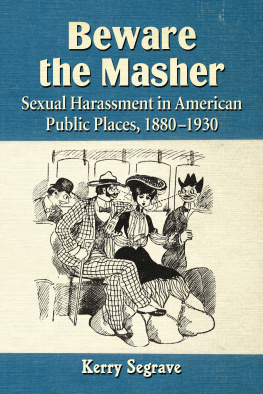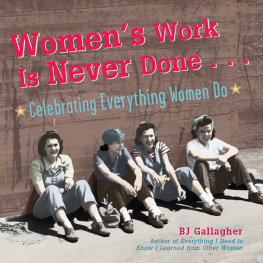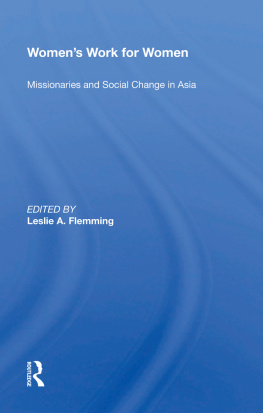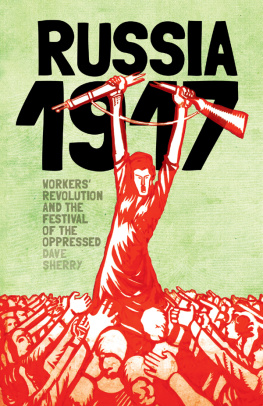Women and Work in Russia
18801930
WOMEN AND MEN IN HISTORY
This series, published for students, scholars and interested general readers, will tackle themes in gender history from the early medieval period through to the present day. Gender issues are now an integral part of all history courses and yet many traditional text books do not reflect this change. Much exciting work is now being done to redress the gender imbalances of the past, and we hope that these books will make their own substantial contribution to that process. This is an open-ended series, which means that many new titles can be included. We hope that these will both synthesise and shape future developments in gender studies.
The General Editors of the series are Patricia Skinner (University of Southampton) for the medieval period; Pamela Sharpe (University of Bristol) for the early modern period; and Margaret Walsh (University of Nottingham) for the modern period.
Published books:
Gender, Church, and State in Early Modern Germany:
Essays by Merry E. Wiesner
Merry E. Wiesner
Gender and Society in Renaissance Italy
Judith C. Brown and Robert C. Davis (eds)
Women and Work in Russia, 18801930:
A Study in Continuity through Change
Jane McDermid and Anna Hillyar
Women and
Work in Russia
18801930
A Study in Continuity through Change
JANE MCDERMID AND ANNA HILLYAR
First published 1998 by Addison Wesley Longman Limited
Published 2014 by Routledge
2 Park Square, Milton Park, Abingdon, Oxon OX14 4RN
711 Third Avenue, New York, NY 10017, USA
Routledge is an imprint of the Taylor & Francis Group,
an informa business
Copyright 1998, Taylor & Francis.
The right of Jane McDermid and Anna Hillyar to be identified
as authors of this Work has been asserted by them in
accordance with the Copyright, Designs and Patents Act 1988.
All rights reserved. No part of this book may be reprinted or
reproduced or utilised in any form or by any electronic, mechanical, or
other means, now known or hereafter invented, including photocopying
and recording, or in any information storage or retrieval system, without
permission in writing from the publishers.
Notices
Knowledge and best practice in this field are constantly changing. As
new research and experience broaden our understanding, changes in
research methods, professional practices, or medical treatment may
become necessary.
Practitioners and researchers must always rely on their own experience
and knowledge in evaluating and using any information, methods,
compounds, or experiments described herein. In using such
information or methods they should be mindful of their own safety and
the safety of others, including parties for whom they have a professional
responsibility.
To the fullest extent of the law, neither the Publisher nor the authors,
contributors, or editors, assume any liability for any injury and/or
damage to persons or property as a matter of products liability,
negligence or otherwise, or from any use or operation of any methods,
products, instructions, or ideas contained in the material herein.
ISBN 13: 978-0-582-27986-5 (pbk)
British Library Cataloguing in Publication Data
A catalogue record for this tide is
available from the British Library
Library of Congress Cataloging-in-Publication Data
A catalog entry for this book is
available from the Library of Congress
Set by 35 in 10/12pt Baskerville
Contents
This book would not have been possible without the dedicated work of librarians in a number of institutions and countries, and in particular those who work in the inter-library loan service. Staff at the Bodleian library in Oxford, the library of the School of Slavonic and East European Studies at London University, the Russian State library in Moscow, the Saltykov-Shchedrin library in St. Petersburg, and Tomsk University library were generous with their time and expertise. Special thanks is owed to Dorothy Stratford of the Philip Lawrence library at LSU College, Southampton (now University of Southampton New College).
We are also grateful to those who read and commented on the manuscript: Hilary Shaw of Longman (whose patient encouragement and sympathetic understanding kept the book on track), Maggie Walsh of Nottingham University, Jan Rutter at LSU College, Frank Cogliano formerly of LSU now at Edinburgh University, and in particular James D. White at the Institute of Russian and East European Studies, Glasgow University. We have tried to incorporate all of their suggestions, from which the final draft has benefited substantially. Of course, this does not absolve the authors of responsibility for any remaining weaknesses.
This work is a collaborative effort, not simply because there are two authors, but also because, as the bibliography will show, we are indebted to the work of many American and British historians. Our intention was to build on their scholarship by shedding light on a specific area of the history of Russian women. We hope that our book will encourage newcomers to this field to turn to the work of those pioneers on whose shoulders we perch, such as Richard Stites, Barbara Alpern Engel and Linda Edmondson.
Finally, this work began when we were both employed at La Sainte Union College in Southampton. We feel tremendous gratitude to and affection for an institution whose staff and students throughout its existence (19041997) embraced a genuine community spirit. It is to them and to the religious order which established LSU that this book is dedicated.
The best relief from sad thoughts is work thought Vera Pavlovna, and she was quite right.
N.G. Chernyshevsky, What is to be done?, 1863
Alexandra Kollontai (18721953) is generally accepted, at least in the West, as a, if not the, central figure in the movement for the liberation of women in Russia and in the development of Marxist theory on sexual relations. In particular, Kollontai insisted that work and not emotion should be the centre of womens lives, and further that it was productive work, by which she meant paid employment outside the home, which would make women independent and personally fulfilled. She wrote that womans position, her rights, her recognition as an individual, her access to the storehouse of learning always follow from her role in the economy and in production.1
In practice, before the revolution of 1917, although marriage was the destiny of the majority of Russian women, the stress was on the productive as well as reproductive value which they could contribute to the family economy. That economy changed dramatically with the abolition of serfdom in 1861, which made the peasant womans ability to contribute to the household economy, whether by farming or through crafts, even more crucial for its survival, while it forced many upper-class women for the first time to support themselves. Thus the location of womens work after 1861 differed according to class, with the majority of peasant women tied to the home, and considerable numbers of gentry women pushed out of it. With the push for industrialisation from the 1880s, but especially from the 1890s, alongside growing impoverishment of the peasantry, more and more women were drawn to the towns in search of work. Often the type of employment which they found differed little from their village experience of work, especially domestic service, textiles, and cultivating kitchen gardens. However, as urbanisation developed and industry became more complex, women found a widening choice of jobs. Indeed, as the political opposition to the absolutist system of rule erupted into revolution in 1905, employers turned increasingly to women as replacements for male workers, who were considered less reliable, not just politically but also because of their indiscipline, reflected most commonly in drunkenness.






